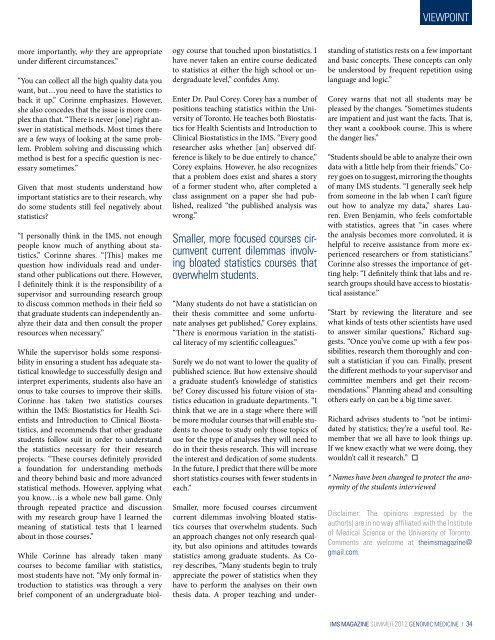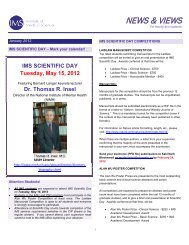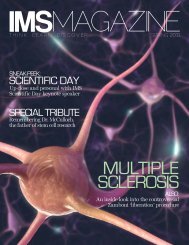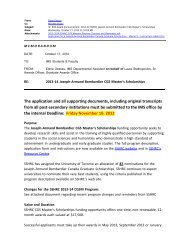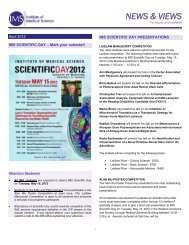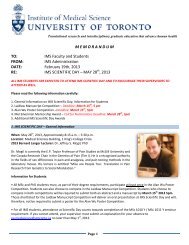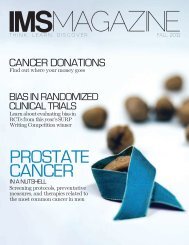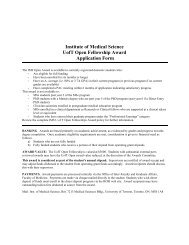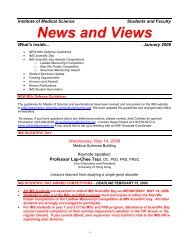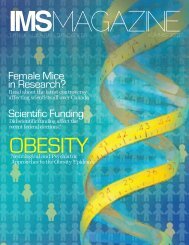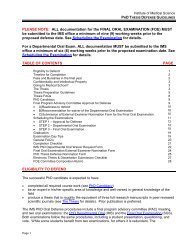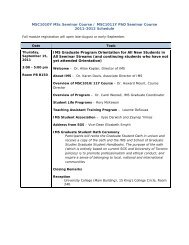IMS Magazine - Summer 2012 edition in PDF format - Institute of ...
IMS Magazine - Summer 2012 edition in PDF format - Institute of ...
IMS Magazine - Summer 2012 edition in PDF format - Institute of ...
Create successful ePaper yourself
Turn your PDF publications into a flip-book with our unique Google optimized e-Paper software.
VIEWPOINT<br />
more importantly, why they are appropriate<br />
under different circumstances.”<br />
“You can collect all the high quality data you<br />
want, but…you need to have the statistics to<br />
back it up,” Cor<strong>in</strong>ne emphasizes. However,<br />
she also concedes that the issue is more complex<br />
than that. “There is never [one] right answer<br />
<strong>in</strong> statistical methods. Most times there<br />
are a few ways <strong>of</strong> look<strong>in</strong>g at the same problem.<br />
Problem solv<strong>in</strong>g and discuss<strong>in</strong>g which<br />
method is best for a specific question is necessary<br />
sometimes.”<br />
Given that most students understand how<br />
important statistics are to their research, why<br />
do some students still feel negatively about<br />
statistics?<br />
“I personally th<strong>in</strong>k <strong>in</strong> the <strong>IMS</strong>, not enough<br />
people know much <strong>of</strong> anyth<strong>in</strong>g about statistics,”<br />
Cor<strong>in</strong>ne shares. “[This] makes me<br />
question how <strong>in</strong>dividuals read and understand<br />
other publications out there. However,<br />
I def<strong>in</strong>itely th<strong>in</strong>k it is the responsibility <strong>of</strong> a<br />
supervisor and surround<strong>in</strong>g research group<br />
to discuss common methods <strong>in</strong> their field so<br />
that graduate students can <strong>in</strong>dependently analyze<br />
their data and then consult the proper<br />
resources when necessary.”<br />
While the supervisor holds some responsibility<br />
<strong>in</strong> ensur<strong>in</strong>g a student has adequate statistical<br />
knowledge to successfully design and<br />
<strong>in</strong>terpret experiments, students also have an<br />
onus to take courses to improve their skills.<br />
Cor<strong>in</strong>ne has taken two statistics courses<br />
with<strong>in</strong> the <strong>IMS</strong>: Biostatistics for Health Scientists<br />
and Introduction to Cl<strong>in</strong>ical Biostatistics,<br />
and recommends that other graduate<br />
students follow suit <strong>in</strong> order to understand<br />
the statistics necessary for their research<br />
projects. “These courses def<strong>in</strong>itely provided<br />
a foundation for understand<strong>in</strong>g methods<br />
and theory beh<strong>in</strong>d basic and more advanced<br />
statistical methods. However, apply<strong>in</strong>g what<br />
you know…is a whole new ball game. Only<br />
through repeated practice and discussion<br />
with my research group have I learned the<br />
mean<strong>in</strong>g <strong>of</strong> statistical tests that I learned<br />
about <strong>in</strong> those courses.”<br />
While Cor<strong>in</strong>ne has already taken many<br />
courses to become familiar with statistics,<br />
most students have not. “My only formal <strong>in</strong>troduction<br />
to statistics was through a very<br />
brief component <strong>of</strong> an undergraduate biol-<br />
ogy course that touched upon biostatistics. I<br />
have never taken an entire course dedicated<br />
to statistics at either the high school or undergraduate<br />
level,” confides Amy.<br />
Enter Dr. Paul Corey. Corey has a number <strong>of</strong><br />
positions teach<strong>in</strong>g statistics with<strong>in</strong> the University<br />
<strong>of</strong> Toronto. He teaches both Biostatistics<br />
for Health Scientists and Introduction to<br />
Cl<strong>in</strong>ical Biostatistics <strong>in</strong> the <strong>IMS</strong>. “Every good<br />
researcher asks whether [an] observed difference<br />
is likely to be due entirely to chance,”<br />
Corey expla<strong>in</strong>s. However, he also recognizes<br />
that a problem does exist and shares a story<br />
<strong>of</strong> a former student who, after completed a<br />
class assignment on a paper she had published,<br />
realized “the published analysis was<br />
wrong.”<br />
Smaller, more focused courses circumvent<br />
current dilemmas <strong>in</strong>volv<strong>in</strong>g<br />
bloated statistics courses that<br />
overwhelm students.<br />
“Many students do not have a statistician on<br />
their thesis committee and some unfortunate<br />
analyses get published,” Corey expla<strong>in</strong>s.<br />
“There is enormous variation <strong>in</strong> the statistical<br />
literacy <strong>of</strong> my scientific colleagues.”<br />
Surely we do not want to lower the quality <strong>of</strong><br />
published science. But how extensive should<br />
a graduate student’s knowledge <strong>of</strong> statistics<br />
be? Corey discussed his future vision <strong>of</strong> statistics<br />
education <strong>in</strong> graduate departments. “I<br />
th<strong>in</strong>k that we are <strong>in</strong> a stage where there will<br />
be more modular courses that will enable students<br />
to choose to study only those topics <strong>of</strong><br />
use for the type <strong>of</strong> analyses they will need to<br />
do <strong>in</strong> their thesis research. This will <strong>in</strong>crease<br />
the <strong>in</strong>terest and dedication <strong>of</strong> some students.<br />
In the future, I predict that there will be more<br />
short statistics courses with fewer students <strong>in</strong><br />
each.”<br />
Smaller, more focused courses circumvent<br />
current dilemmas <strong>in</strong>volv<strong>in</strong>g bloated statistics<br />
courses that overwhelm students. Such<br />
an approach changes not only research quality,<br />
but also op<strong>in</strong>ions and attitudes towards<br />
statistics among graduate students. As Corey<br />
describes, “Many students beg<strong>in</strong> to truly<br />
appreciate the power <strong>of</strong> statistics when they<br />
have to perform the analyses on their own<br />
thesis data. A proper teach<strong>in</strong>g and under-<br />
stand<strong>in</strong>g <strong>of</strong> statistics rests on a few important<br />
and basic concepts. These concepts can only<br />
be understood by frequent repetition us<strong>in</strong>g<br />
language and logic.”<br />
Corey warns that not all students may be<br />
pleased by the changes. “Sometimes students<br />
are impatient and just want the facts. That is,<br />
they want a cookbook course. This is where<br />
the danger lies.”<br />
“Students should be able to analyze their own<br />
data with a little help from their friends,” Corey<br />
goes on to suggest, mirror<strong>in</strong>g the thoughts<br />
<strong>of</strong> many <strong>IMS</strong> students. “I generally seek help<br />
from someone <strong>in</strong> the lab when I can’t figure<br />
out how to analyze my data,” shares Lauren.<br />
Even Benjam<strong>in</strong>, who feels comfortable<br />
with statistics, agrees that “<strong>in</strong> cases where<br />
the analysis becomes more convoluted, it is<br />
helpful to receive assistance from more experienced<br />
researchers or from statisticians.”<br />
Cor<strong>in</strong>ne also stresses the importance <strong>of</strong> gett<strong>in</strong>g<br />
help: “I def<strong>in</strong>itely th<strong>in</strong>k that labs and research<br />
groups should have access to biostatistical<br />
assistance.”<br />
“Start by review<strong>in</strong>g the literature and see<br />
what k<strong>in</strong>ds <strong>of</strong> tests other scientists have used<br />
to answer similar questions,” Richard suggests.<br />
“Once you’ve come up with a few possibilities,<br />
research them thoroughly and consult<br />
a statistician if you can. F<strong>in</strong>ally, present<br />
the different methods to your supervisor and<br />
committee members and get their recommendations.”<br />
Plann<strong>in</strong>g ahead and consult<strong>in</strong>g<br />
others early on can be a big time saver.<br />
Richard advises students to “not be <strong>in</strong>timidated<br />
by statistics; they’re a useful tool. Remember<br />
that we all have to look th<strong>in</strong>gs up.<br />
If we knew exactly what we were do<strong>in</strong>g, they<br />
wouldn’t call it research.”<br />
* Names have been changed to protect the anonymity<br />
<strong>of</strong> the students <strong>in</strong>terviewed<br />
Disclaimer: The op<strong>in</strong>ions expressed by the<br />
author(s) are <strong>in</strong> no way affiliated with the <strong>Institute</strong><br />
<strong>of</strong> Medical Science or the University <strong>of</strong> Toronto.<br />
Comments are welcome at theimsmagaz<strong>in</strong>e@<br />
gmail.com.<br />
<strong>IMS</strong> MAGAZINE SUMMER <strong>2012</strong> GENOMIC MEDICINE | 34


